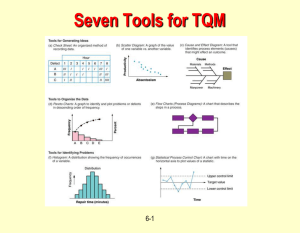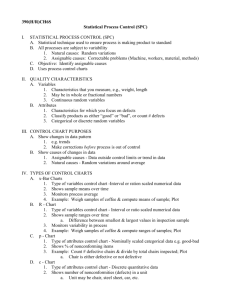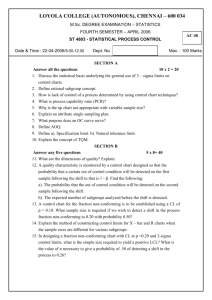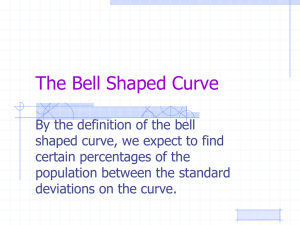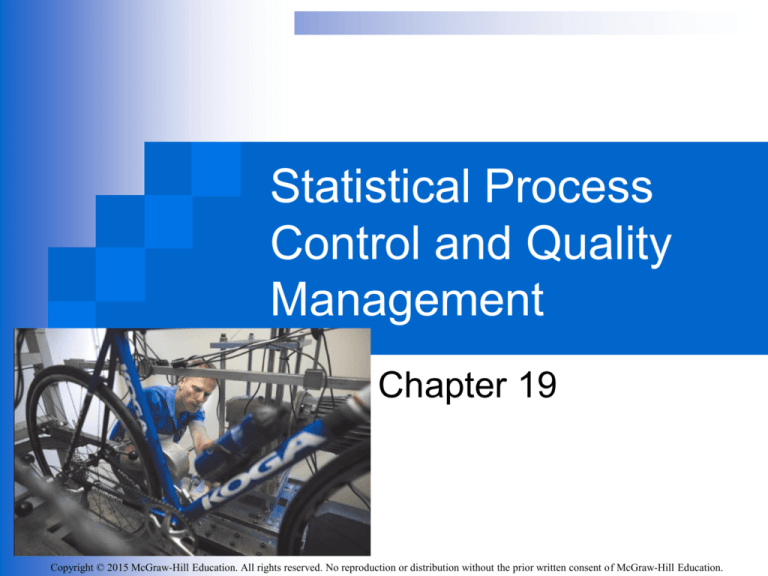
Statistical Process
Control and Quality
Management
Chapter 19
Copyright © 2015 McGraw-Hill Education. All rights reserved. No reproduction or distribution without the prior written consent of McGraw-Hill Education.
Learning Objectives
LO19-1 Explain the purpose of quality control in production
and service operations.
LO19-2 Define the two sources of process variation and
explain how they are used to monitor quality.
LO19-3 Explain the use of charts to investigate the sources of
process variation.
LO19-4 Compute control limits for mean and range control
charts for a variable measure of quality.
LO19-5 Evaluate control charts to determine if a process is out
of control.
LO19-6 Compute control limits of control charts for an attribute
measure of quality.
LO19-7 Explain the process of acceptance sampling.
19-2
LO19-1 Explain the purpose of quality
control in production and service operations.
Control Charts:
Are useful tools for monitoring a process.
Used to identify sources of variation in a process.
Common Cause
Special Cause
Used to identify when assignable causes of variation
have entered the process.
Used to determine that the process being monitored
is not in control.
Are analyzed to help determine the sources of
variation, which can then be eliminated to bring the
process back into control.
19-3
LO19-1
Six Sigma
Six Sigma is a typical program designed to improve quality and
performance throughout a company.
It combines methodology, tools, software, and education to deliver
a completely integrated approach to waste elimination and
process capability improvement.
The approach requires defining the process function; identifying,
collecting, and analyzing data; creating and consolidating
information into useful knowledge; and the communication and
application of such knowledge to reduce variation.
Six Sigma gets its name from the normal distribution. The term
sigma means standard deviation, and “plus or minus” three
standard deviations gives a total range of six standard deviations.
So Six Sigma means having no more than 3.4 defects per million
opportunities in any process, product, or service.
19-4
LO19-2 Define the two sources of process variation
and explain how they are used to monitor quality.
Causes of Variation
All manufacturing and service processes vary in their performance.
The two sources of variation are:
19-5
LO19-3 Explain the use of charts to
investigate the sources of process variation.
Diagnostic Charts
There are a variety of diagnostic techniques available to investigate quality
problems.
Two of the more prominent of these techniques are Pareto charts and
fishbone diagrams.
19-6
LO19-3
Pareto Charts
Pareto analysis is a technique for tallying the number
and type of service or product defects and
investigating the source of the defects. This
information is summarized in a Pareto Chart.
The chart is named after a nineteenth-century Italian
scientist, Vilfredo Pareto. Pareto’s Principle, often
called the 80–20 rule, is that 80 percent variation is
explained by 20 percent of the possible causes. In
application, quality control efforts should focus on the
20 percent of the causes of the variation that causes
poor quality.
19-7
LO19-3
Pareto Chart - Example
The city manager of Grove City, Utah, is concerned with water usage in
single family homes. To investigate, she selects a sample of 100 homes and
determines the typical daily water usage for various purposes. The sample
results are as follows.
19-8
LO19-3
Fishbone Diagrams
Another diagnostic chart is a
cause-and-effect diagram or a
fishbone diagram. It is called a
cause-and-effect
diagram
to
emphasize
the
relationship
between an effect and a set of
possible causes that produce the
particular effect.
This diagram is useful to help
organize ideas and to identify
relationships. It is a tool that
encourages open brainstorming for
ideas.
By
identifying
these
relationships we can determine
factors that are the cause of
variability in our process.
19-9
LO19-4 Compute control limits for mean and range
control charts for a variable measure of quality.
Purpose and Types of Quality Control
Charts
The purpose of quality-control charts is to graphically track process
variation over time so that we can detect when an assignable cause
enters the production system. As “assignable variation”, a manager
then investigates and identifies cause and attempts to eliminate the
source of the assignable variation.
Types of Quality Control Charts:
Control Charts for Attributes – involves “counting”
Control Charts for Variables – involves “measuring”
19-10
LO19-4
Mean and Range Chart for Variables
A mean or the X-bar chart is designed to monitor process variables such as
weight, length, etc. The upper control limit (UCL) and the lower control limit
(LCL) are obtained from the equation:
A range chart shows the variation in the sample ranges.
R
Where:
n is the sample size
X is the mean of the sample means
R is the mean of the ranges
D3 and D4 values are found in Appendix B.10
19-11
LO19-4
Mean Chart for Variables - Example
Statistical Software, Inc., offers a tollfree number that customers can call
with problems involving the use of
their products from 7 A.M. until 11
P.M. daily. While it is not possible to
answer all calls immediately, it is
important customers do not wait too
long for a person to come on the line.
To understand its process, Statistical
Software decides to develop a control
chart describing the total time from
when a call is received until the
representative answers the call and
resolves the issue raised by the
caller. For the 16 hours of operation
in one day, five calls were sampled
each hour. This information is on the
table, in minutes, until the issue was
resolved.
Based on this information, develop
a control chart for the mean
duration of the call. Does there
appear to be a trend in the calling
times? Is there any period in which
it appears that customers wait
longer than others?
19-12
LO19-4
Constructing a Mean Chart
19-13
LO19-4
Constructing a Range Chart Example
Develop a control chart for
the range. Does it appear
that there is any time when
there is too much variation
in the operation?
19-14
LO19-4
Range Chart - Example
R
102
6.375
16
15
19-15
LO19-4
Mean and Range Charts Minitab
19-16
LO19-5 Evaluate control charts to
determine if a process is out of control.
In-Control Situation
19-17
LO19-5
Mean Out-of-control, Range in-control
19-18
LO19-5
Mean In-control, Range Out-of-control
19-19
LO19-6 Compute control limits of control
charts for an attribute measure of quality.
Attribute Control Chart: The p-Chart
The percent defective chart is also called a
p-chart or the p-bar chart.
It graphically monitors a process by showing
the proportion defective over time.
19-20
LO19-6
Attribute Control Chart: The pChart
19-21
LO19-6
p-Chart Example
Jersey Glass Company, Inc., produces
small hand mirrors. Each day, the
quality assurance department (QA)
monitors the quality of the mirrors
twice during the day shift and twice
during the evening shift. After each
four-hour period, QA selects and
carefully inspects a random sample of
50 mirrors, classifies each mirror as
either acceptable or unacceptable and
counts the number of mirrors in the
sample that do not conform to quality
specifications. Listed below is the
result of these checks over the last 10
business days.
Construct a percent defective chart
for this process. What are the upper
and lower control limits? Interpret
the results. Does it appear the
process is out of control during the
period?
19-22
LO19-6
Computing the Control Limits
19-23
LO19-6
p-Chart using Minitab
19-24
LO19-6
Attribute Control Chart : The c-Chart
The c-chart or the c-bar chart is designed to monitor a
process by counting the number of defects per unit.
The UCL and LCL are found by:
19-25
LO19-6
c-Chart Example
The publisher of the Oak Harbor Daily Telegraph is concerned about the
number of misspelled words in the daily newspaper. It does not print a
paper on Saturday or Sunday. In an effort to control the problem and
promote the need for correct spelling, a control chart will be used. The
number of misspelled words found in the final edition of the paper for the
last 10 days is: 5, 6, 3, 0, 4, 5, 1, 2, 7, and 4.
Determine the appropriate control limits and interpret the chart. Were
there any days during the period that the number of misspelled words
was out of control?
19-26
LO19-6
c-Chart in Minitab
19-27
LO19-7 Explain the process
of acceptance sampling.
Acceptance Sampling
Method of determining whether
an incoming lot of a product
meets specified standards.
Based on random sampling techniques.
A random sample of n units is obtained
from the entire lot.
c is the maximum number of defective
units that may be found in the sample
for the lot to still be considered
acceptable.
19-28
LO19-7
Acceptance Sampling Procedure
Accept shipment or reject shipment?
The usual procedure is to screen the quality of incoming parts by using
a statistical sampling plan.
According to this plan, a sample of n units is randomly selected from a
lot of N units (the population). This is called acceptance sampling.
The inspection will determine the number of defects in the sample. This
number is compared with a predetermined number called the critical
number or the acceptance number. The acceptance number is
usually designated c.
If the number of defects in the sample of size n is less than or equal to
c, the lot is accepted.
If the number of defects exceeds c, the lot is rejected and returned to
the supplier, or perhaps submitted to 100 percent inspection.
19-29
LO19-7
Consumer’s Risk vs. Producer’s Risk in
Acceptance Sampling
Type II Error
Type I Error
19-30
LO19-7
Operating Characteristic Curve
An OC curve, or, operating characteristic curve
is developed using the binomial probability
distribution in order to determine the probabilities
of accepting lots of various quality level .
19-31
LO19-7
OC Curve - Computation Example
Sims Software purchases DVDs from DVD
International. The DVDs are packaged in lots
of 1,000 each. Todd Sims, president of Sims
Software, has agreed to accept lots with 10
percent or fewer defective DVDs. Todd has
directed his inspection department to select a
random sample of 20 DVDs and examine
them carefully. He will accept the lot if it has
two or fewer defectives in the sample.
Develop an OC curve for this inspection
plan. What is the probability of accepting
a lot that is 10 percent defective?
19-32
LO19-7
OC Curve - Computation Example
This type of sampling is called attribute sampling
because the sampled item, a DVD in this case, is
classified as acceptable or unacceptable.
Let represent the actual proportion defective in the
population.
The lot is good if ≤ .10.
The lot is bad if > .10.
Let X be the number of defects in the sample. The
decision rule is:
Accept the lot if X ≤ 2.
Reject the lot if X ≥ 3.
19-33
LO19-7
OC Curve - Computation Example
The binomial distribution is used to compute the various
values on the OC curve. Recall that the binomial has four
requirements:
1. There are only two possible outcomes. Here the DVD is either
acceptable or unacceptable.
2. There is a fixed number of trials. In this instance the number of trials
is the sample size of 20.
3. There is a constant probability of success. A success is finding a
defective DVD. The probability of success is assumed to be .10.
4. The trials are independent. The probability of obtaining a defective
DVD on the third one selected is not related to the likelihood of
finding a defect on the fourth DVD selected.
19-34
LO19-7
OC Curve - Computation Example
The table shows six binomial
distributions with pi equal to
0.05, 0.10, 0.15, 0.20, 0.25,
and 0.30. The number of
trials is the same for all, 20.
19-35
LO19-7
OC Curve - Computation Example
To begin we determine the probability of accepting a lot that is 5 percent
defective. This means that = .05, c = 2, and n = 20. From the Excel output,
the likelihood of selecting a sample of 20 items from a shipment that contained
5 percent defective and finding exactly 0 defects is .358. The likelihood of
finding exactly 1 defect is .377, and finding 2 is .189. Hence the likelihood of 2
or fewer defects is .924, found by .358 +.377 + .189. This result is usually
written in shorthand notation
P(x≤ 2 | = .05 and n = 20) = .358 + .377 + .189 = .924
The likelihood of accepting a lot that is actually 10 percent defective is .677.
P(x≤ 2 | = .10 and n = 20) = .122 + .270 + .285 = .677
The complete OC curve in the next slide shows the smoothed curve for all
values between 0 and about 30 percent.
19-36
LO19-7
OC Curve - Computation Example
19-37




